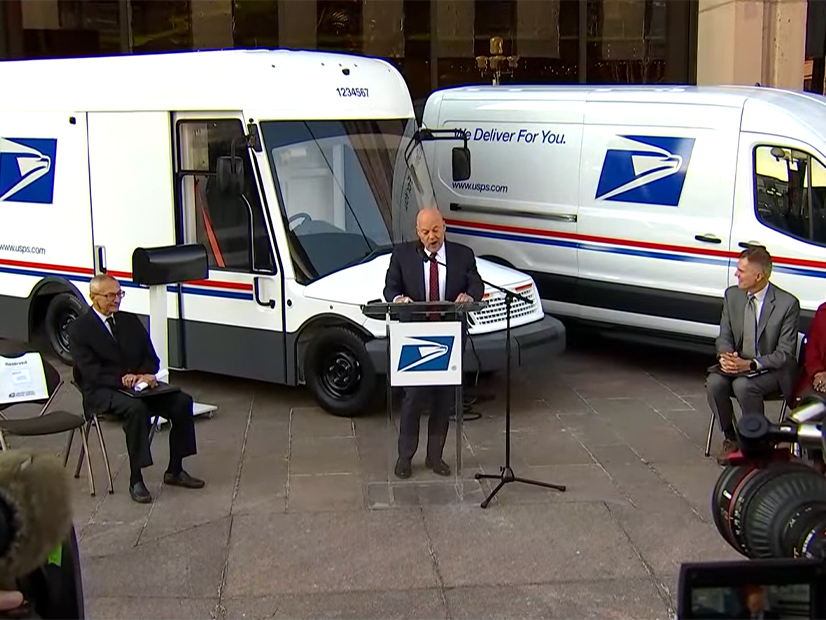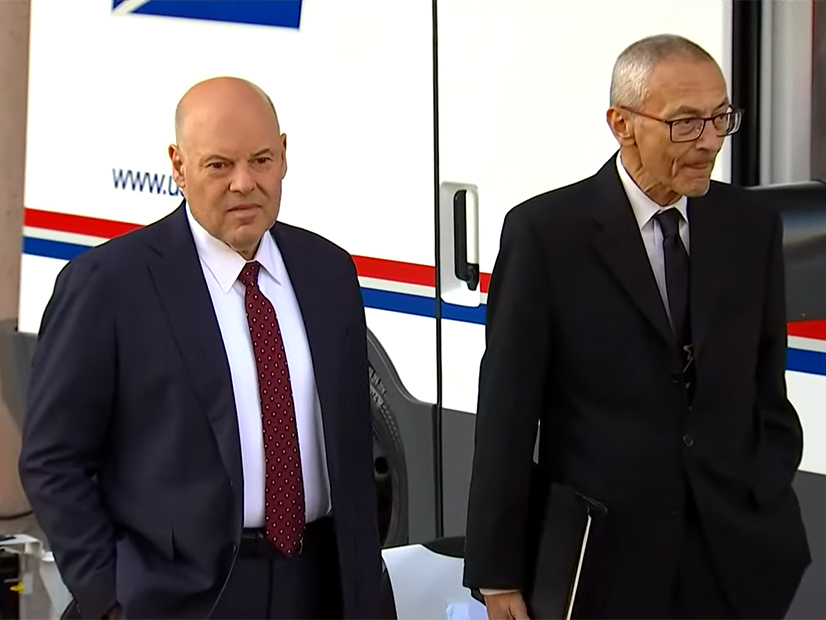
Ending a bureaucratic battle with a Trump-holdover, the Biden administration on Tuesday announced that the U.S. Postal Service will procure 66,000 battery electric vehicles (BEVs) among the 106,000 vehicles the USPS plans to purchase by 2028.
The BEVs will include 45,000 purpose-built next generation delivery vehicles (NGDVs) from Oshkosh Defense and 21,000 commercial off-the-shelf Ford E-Transit vans.
Officials announced the plans at a press conference outside Postal Service Headquarters in Washington that featured Postmaster General Louis DeJoy, John Podesta, senior advisor to the president for clean energy innovation and implementation, Brenda Mallory, chair of the White House Council on Environmental Quality, and National Climate Advisor Ali Zaidi.
The bonhomie between DeJoy and the White House officials was a sharp contrast to the Biden administration’s outrage in February, when the postmaster general announced that as little as 10% of a planned purchase of 165,000 NGDVs would be battery-powered. (DeJoy, a Trump appointee, had earlier earned the ire of Democrats over cost-cutting practices that contributed to a slowdown of mail deliveries before the 2020 presidential election.)
In March, the Postal Service announced a purchase order of 50,000 NGDVs from Oshkosh, including 20% BEVs.
Under pressure from the administration, the service announced in July it would conduct a supplemental environmental impact statement and anticipated at least 50% of its NGDVs would be BEVs.
When Podesta began speaking to DeJoy in September, he told The Washington Post, he informed the postmaster general that his plans remained “completely inadequate.”
“So we stuck with it, pushed it, he pushed back, and we pushed back,” Podesta said.
 Postmaster General Louis DeJoy (left) and John Podesta, senior advisor to President Biden for clean energy innovation and implementation | WUSA9
Postmaster General Louis DeJoy (left) and John Podesta, senior advisor to President Biden for clean energy innovation and implementation | WUSA9
At the press conference Tuesday, DeJoy said the Postal Service’s initial EV plans were limited by the need to rescue it from “an imminent financial and operational crisis that threaten[ed] our existence.”
DeJoy said it suffered from “substantial historic and projected losses, eroding market share, increasing and costly obligations to serve a defective pricing model, burdensome … legislation, a failing infrastructure, high employee turnover, ineffective organizational and operational strategies and an aging fleet of over 200,000 delivery vehicles that are best suited for museums rather than for our hard-working carriers.”
DeJoy thanked Congress and the White House climate team for collaborating with the service to overcome its financial and operational obstacles, saying the announced procurement was “an operationally suitable, financially viable and climate-friendly acquisition and deployment strategy.”
DeJoy said the service also is launching an initiative to reduce operating costs “through a massive network reconfiguration” that will reduce air cargo, handling and truck trips.
“The tremendous initiative we are now announcing today is directionally where we anticipated landing all along,” he added. “As our financial trajectory improved, as our delivery strategy evolved, and with the help of the congressional funds to facilitate our ambition, we were very well positioned to move forward with more favorable plans that everyone can rally around.”
Although most of the $9.6 billion price tag will be funded from Postal Service revenues, the accelerated transition was aided by the Inflation Reduction Act, which will provide $1.3 billion for vehicle purchases and $1.7 billion for charging infrastructure.
DeJoy said the service expects the NGDVs it acquires in 2026 through 2028 to be BEVs. “One hundred percent electric, John,” he said, turning to Podesta. “One hundred percent.”
Podesta was also gracious when it was his turn to speak, thanking DeJoy for “his personal leadership in making this day possible.”
Podesta noted that the postal service delivery van is one of the most recognizable vehicles on the road. “So it’s wonderful that the Postal Service will be at the forefront of the switch to clean electric vehicles, with postal workers as their ambassadors. It will get people thinking, ‘If the postal worker delivering our Christmas presents … is driving in an EV, I can drive an EV too.’”
Podesta noted that the Postal Service has the second highest carbon footprint of any federal agency. “So converting to clean electric vehicles is an essential part of making sure that the federal government is walking the walk on climate — and a big demand signal to the rest of the transportation sector to go electric.”
The NGDVs are expected to go into service in late 2023. In addition to not emitting carbon, the new vehicles will be air-conditioned and have air bags, unlike the vans they will replace.

